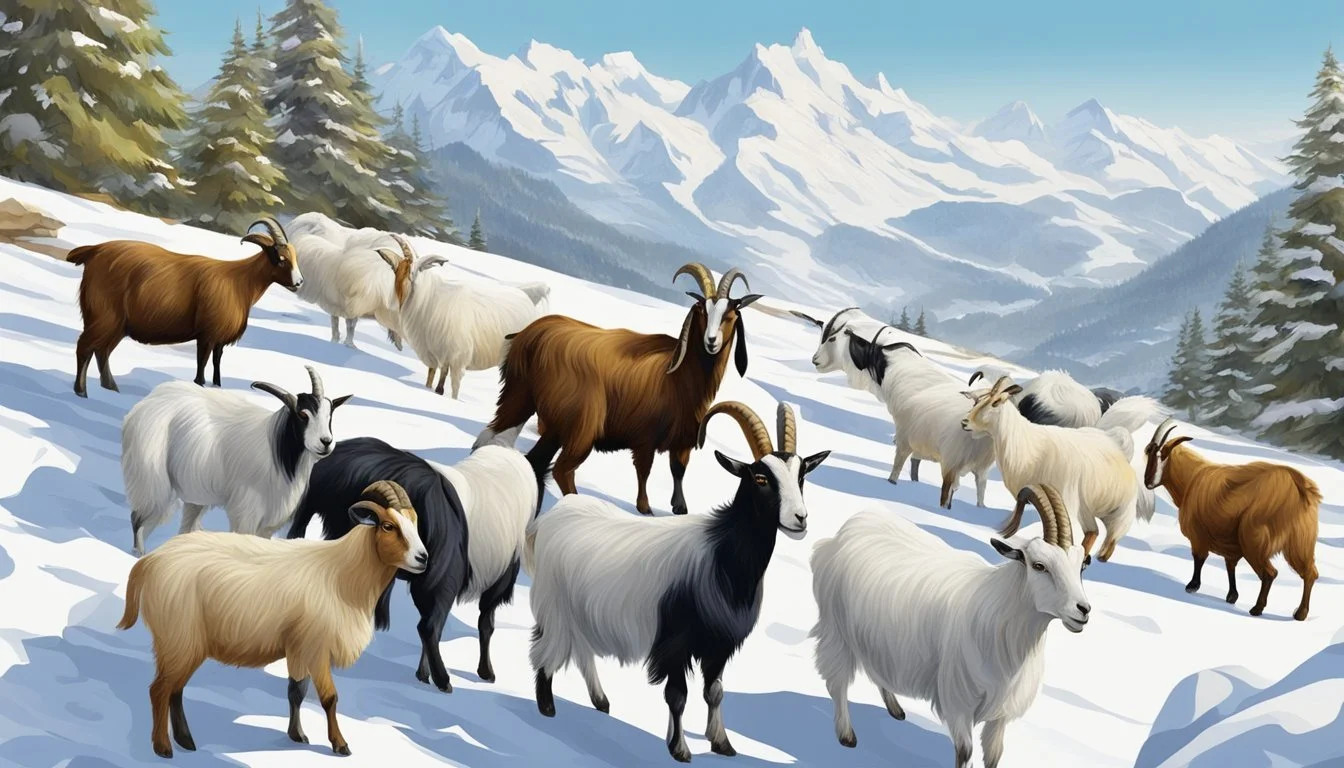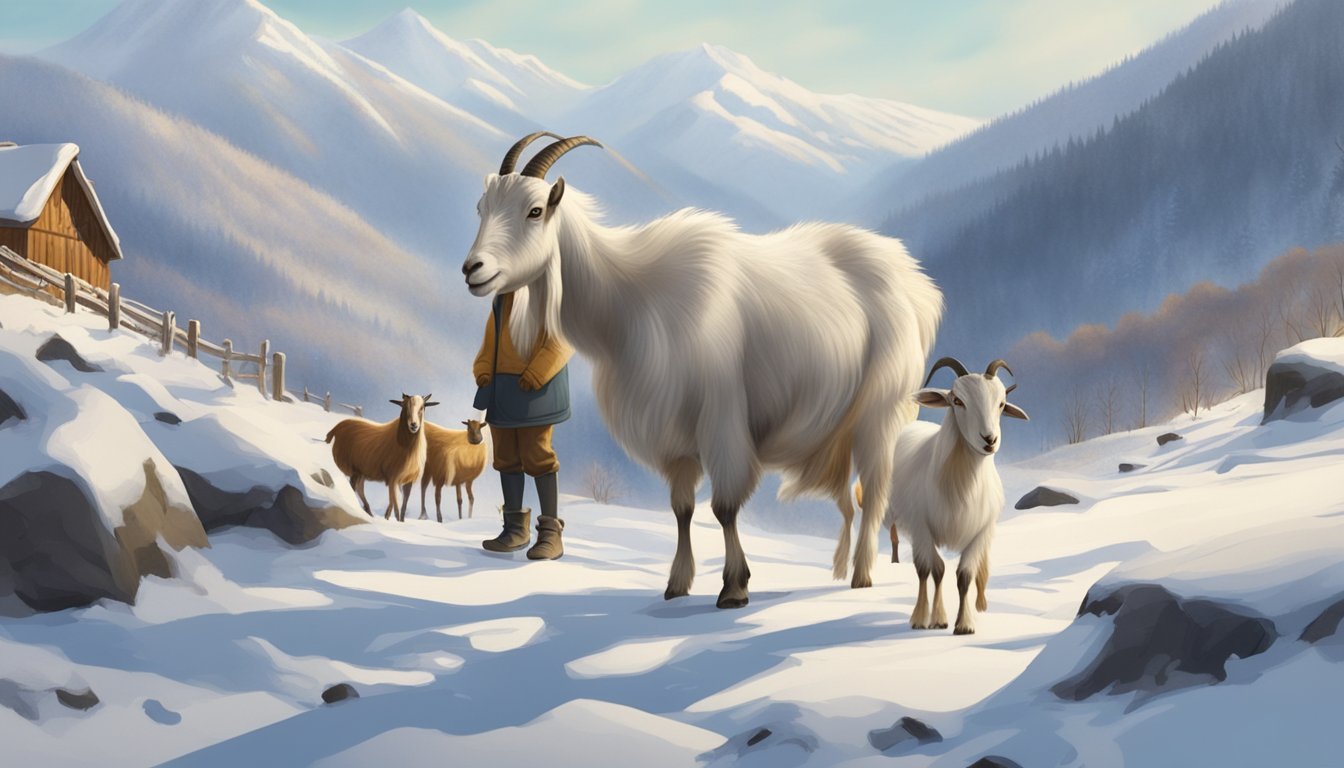The Best Milking Goat Breeds for Cold Climates
Top Hardy Choices
Selecting the right goat breeds for cold climates is crucial for farmers who need to maintain productivity throughout the year, especially for dairy production. Certain breeds have adapted remarkably well to cooler temperatures, and their resilience makes them ideal for places with harsh winter conditions. These goats not only survive but thrive in cold weather, continuing to produce milk efficiently when other breeds might struggle.
Alpine goats, native to the chilly Swiss Alps, are one of the top choices for cold weather. Known for their hardiness and adaptability, they are excellent foragers and can navigate steep, rocky terrain with ease. Their milk yield is substantial, and they have a history of being used in mountainous regions where other animals might not graze. Similarly, the Saanen breed, which hails from Switzerland, is revered for its impressive milk production, often referred to as the "Queen of Milk." These robust animals are another promising option for cold climates due to their ability to produce a generous amount of milk despite the cold.
In addition to these, the Kiko goat, originally from the temperate climate of New Zealand, has shown considerable adaptability to various environments, including cooler regions. Kikos are recognized for their meat, but they have dairy lineage that contributes useful traits to their character. These goats are prized for their survival traits, fecundity, and foraging ability, making them a versatile choice for a cold-climate dairy and meat goat.
Understanding Goat Breeds for Cold Climates
When considering goat breeds for cold climates, one must evaluate their resilience to low temperatures and their adaptability to harsh winter conditions, which is often evident through their physical characteristics such as thick winter coats.
Defining Cold-Hardy Characteristics
Cold-hardy goat breeds exhibit several defining physical attributes that contribute to their adaptability in cold climates. Key traits include:
Long Hair: A dense undercoat to provide insulation.
Winter Coat: An overcoat that is often water-resistant and helps to shield them from snow and wind.
Such breeds are typically rooted in mountainous or northern regions with evolutionary adaptations that allow them to thrive in temperatures that might challenge other breeds.
Importance of Nutrition and Care
Proper nutrition and care are vital for goats in cold weather to maintain their health and milk production. Essential components include:
Forage: High-quality forage is essential for maintaining body heat and energy.
Hay: Free choice quality alfalfa hay is particularly important during the winter months.
Grain: A grain mix may be provided, especially to those in milk production, to support their dietary needs.
Care also involves appropriate shelter to protect from the elements and sufficient space for exercise and digestion. Additionally, access to loose goat mineral and baking soda can aid in maintaining optimal rumen function and overall health.
Top Cold-Hardy Dairy Goat Breeds
Selecting the right goat breed for cold climates is crucial for farmers and homesteaders to ensure good milk production throughout the year. Cold-hardy goats not only endure the chill but continue to produce milk consistently. Here are some of the top dairy goat breeds that are known for their resilience in colder weather.
Alpine Goats
Alpine goats, including the French Alpine and Swiss Alpine, are robust and adapt well to cooler climates. They are known for their steady milk production, and the milk flavor is favored among dairy goat breeds. With their medium to large build, they can yield a substantial quantity of milk.
Toggenburg Goats
Toggenburg goats are recognized for their quiet and productive nature. These goats, originating from Switzerland, provide milk with a distinctive flavor and are consistent in terms of milk production. Their sturdy build and dense coat serve them well in colder environments.
Oberhasli Goats
The Oberhasli goat, with its striking appearance and gentle temperament, is also suited for colder climates. They possess well-developed udders and give milk that is high in both quality and taste. Their durability makes them a suitable choice as dairy goat breeds for homesteaders in colder regions.
Saanen Goats
Often referred to as the "queen of the dairy goats," Saanen goats have one of the highest milk production rates and the milk is known for its high protein and moderate butterfat content. Their large, sturdy frames and calm demeanor make Saanens favored as dairy goats.
Nubian Goats
Nubian goats, also known as Anglo-Nubians, are valued for their high butterfat milk which is ideal for cheese-making, and they also contribute well to meat production. With their long, floppy ears and docile temperament, they adapt well to various climates, including the cold.
LaMancha Goats
Unique for their virtually earless appearance, LaMancha goats have an excellent milk production heritage. Despite their shorter ear size, they are fully equipped to handle harsh climates and produce milk with a higher butterfat content, which is a lucrative trait for dairy farmers.
Best Meat and Dual-Purpose Goats for Cold Climates
In regions with harsh winters, selecting goat breeds with resilience to cold and a strong track record in meat production is crucial. The breeds listed below have adapted to colder climates and are prized for their meat, with certain breeds offering reliable milk production for dual-purpose homesteading.
Boer Goats
Boer goats are renowned for their excellent meat production and muscular build, thriving in various climates, including cold weather. They are fast growers, which makes them a preferred choice for meat.
Kiko Goats
Kiko goats are standout performers in meat production due to their exceptional growth rates and adaptability to challenging environments, including cold climates. Their sturdy nature and low-maintenance temperament make them ideal for meat production in less hospitable territories.
Myotonic (Fainting) Goats
Recognized for their unique myotonia that causes them to stiffen and sometimes fall over when startled, Myotonic goats, or Fainting goats, are more than just a curious breed—they are muscular and efficient meat producers, with a constitution that endures cold well.
Spanish Goats
Spanish goats are one of the most hardy meat goat breeds, prized for their resilience which translates into reliable meat production. These goats have a storied history of adapting to different climates, including cold weather.
Dual-Purpose Breeds
For homesteaders looking for versatility, dual-purpose breeds stand out. These breeds provide not only substantial meat production but also sufficient milk production. Breeds that are dual-purpose are valued on a homestead for their ability to fulfill multiple roles, often in challenging climates.
Each of these breeds presents viable options for cold climate farming, bringing robustness and productivity to a homestead looking to optimize both meat and milk output.
Ensuring Proper Health and Winter Care
When raising goats in cold climates, it is vital to focus on their shelter, diet, and health management to ensure their well-being throughout the harsh winter months.
Shelter Needs
Goats require a dry, draft-free environment to thrive during winter. Their shelter should have ample space for each goat to rest comfortably and should be well-insulated to maintain a consistent temperature. Proper ventilation is crucial to prevent moisture buildup, which can lead to respiratory issues. Bedding should be thick and absorbent, preferably straw, to provide both warmth and moisture control.
Feeding Requirements
Cold weather increases a goat's energy demand. Therefore, their diet must be rich in calories to help maintain body temperature and overall health. An increase in the amount of hay is necessary, as it serves as an excellent source of fiber and helps generate internal heat when digested. High-quality grain supplements can also be provided to ensure adequate nutrition. Access to water is essential; it should be kept unfrozen by using heated water buckets or troughs.
Health and Parasite Management
Regular veterinary care is essential to promptly address any health issues that may arise, especially in cold climates where animals can be more vulnerable. Critical to their care is the management of parasites, which can be particularly challenging in winter as they may seek refuge in the warm bodies of livestock. Deworming schedules should be adhered to, as recommended by a veterinarian, and goats should be monitored closely for signs of infestation.
In all, keeping milking goats healthy during winter revolves around providing sturdy shelter, adequate nutrition, and vigilant health and parasite management.
Other Considerations for Raising Goats in Cold Climates
Selecting goat breeds for their milk production capabilities and cold tolerance is just the beginning. Those who raise goats must also consider other key factors such as breeding practices, economic implications, and legal frameworks that can influence the success and sustainability of their goat farming endeavors.
Breeding for Cold Tolerance
Breeding goats for cold tolerance involves careful selection of traits that contribute to resilience in frigid conditions. For example, thicker coats and a robust body condition are essential qualities that help goats conserve heat and endure harsh winters. Breeding programs need to focus on genetic lines with proven resilience to low temperatures, considering both the survival and productivity of the offspring.
Economic Factors
When managing a herd in cold climates, economic factors come into play. Initial costs include infrastructure investment like insulated shelters and heated water systems. Over time, these costs often balance with the benefits, as cold-hardy goats tend to have lower veterinary expenses due to their enhanced resilience. The economic impact of milking goats also relates to the sale of products such as milk, cheese, and potentially fiber, depending on the breed.
Cost Analysis:
Shelter: High upfront costs, long-term savings
Health Care: Reduced due to breed resilience
Product Sales: Variable, based on market demand
Community and Legal Considerations
Raising goats in cold climates is not only a farming challenge but also a community endeavor. Involvement with local farmer groups can provide invaluable support and shared resources. It's also crucial to understand and comply with legal requirements and zoning laws, which may dictate the number of animals allowed, types of structures permitted, and specific husbandry practices.
Legal Checklist:
Zoning: Verify livestock allowances
Permits: Secure necessary documentation
Community Relations: Engage with local farming networks
Each of these considerations requires detailed planning and a commitment to both the animals' welfare and the farm's viability in a cold climate setting.
Goat Products and Their Uses
Goat farming is not only for dairy and meat production; it also provides a range of byproducts that are utilized in various industries. From milk to leather, goats offer an array of valuable products that cater to the needs of people all over the world.
Milk and Dairy Products
Goat Milk is praised for its lower lactose content and digestibility. It can be consumed directly or processed to make a variety of dairy products. Cheese made from goat milk, such as Chèvre, is known for its distinct flavor and creamy texture. Goat milk is also used to create Yogurt and Ice Cream, which are favored for their rich taste. The butterfat content of goat milk greatly influences the richness of these products.
Products:
Cheese: Chèvre, Feta, Gouda
Yogurt: often has probiotics
Ice Cream: known for creamy consistency
Culinary Uses:
Direct Consumption: chilled or warmed
Ingredient in Dishes: sweet and savory recipes
Health-focused Products: lower in lactose
Meat Products
The meat from goats is a great source of protein and is a staple in a variety of global cuisines. It can be prepared in a myriad of ways, including grilling, roasting, stewing, and more. Goat meat production focuses on breeds with the best growth rates and carcass quality to meet the high demand for this lean and flavorful meat.
Culinary Uses:
Roasting: whole goats for traditional feasts
Stewing: flavorful in slow-cooked dishes
Grilling: cuts like chops and leg steaks
Other Products
Besides dairy and meat, goats provide other products such as Fiber, Leather, and Lotions. Fiber goat breeds, like the Angora, yield mohair that's valuable in the textile industry. The leather derived from goats is supple and often used in luxury goods. Moreover, goat milk is an ingredient in skincare products, such as Lotions and Soap, celebrated for their moisturizing properties.
Non-Food Products:
Fiber: Mohair for textiles
Leather: For apparel, accessories
Lotions and Soaps: skin-nourishing benefits





